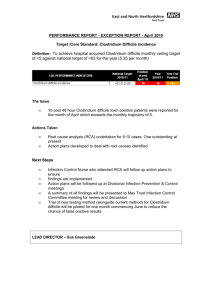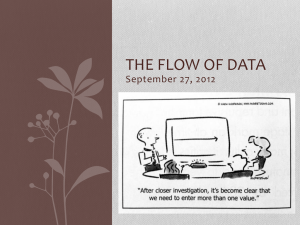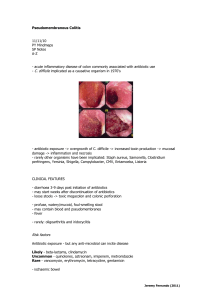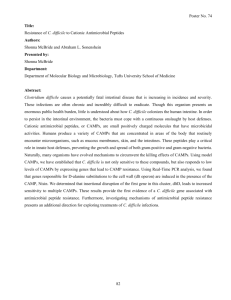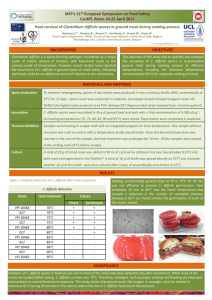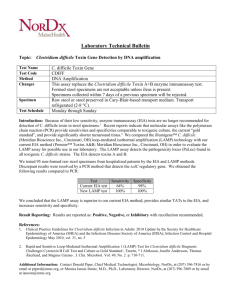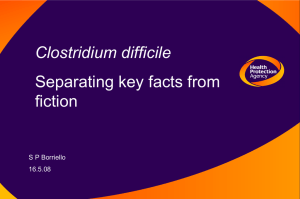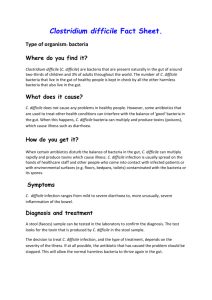C. difficile
advertisement
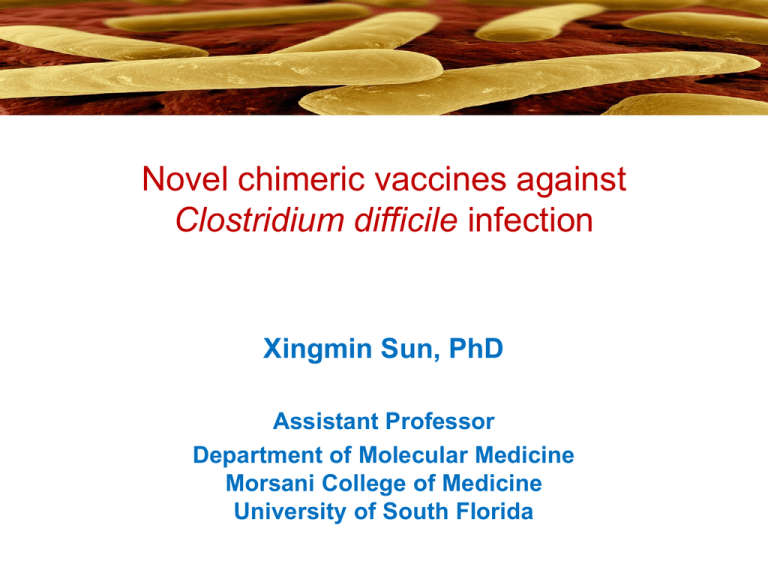
Novel chimeric vaccines against Clostridium difficile infection Xingmin Sun, PhD Assistant Professor Department of Molecular Medicine Morsani College of Medicine University of South Florida Clostridium difficile Gram positive, toxin-producing, spore-forming anaerobic bacterium. One of the three urgent antibiotic resistance threats in US. Leading cause of nosocomial antibiotic-associated diarrhea (AAD) in developed countries. The most common organism to cause healthcare-associated infections in US, leading to 14,000 deaths per year. A continual rise in the incidence of severe C. difficile infection (CDI) has been observed worldwide. Emergence of more virulent strains like NAP1/BI/027: increased toxin production and sporulation; altered antibiotic resistance pattern; secretion of additional toxin. Major virulence factors Toxin A (TcdA) and Toxin B (TcdB): potent cytotoxic enzymes that damage the human colonic mucosa. GTD CPD TMD RBD Binary toxin (CDT): present ~6% of C. difficile isolates, but found in all hypervirulent strains. Major colonization factors Two C. difficile flagellar proteins FliC and FliD are involved in the attachment of the organism to host cells and mucus layer. Serum antibody responses against both FliC and FliD are detected in patients with C. difficile infection. C. difficile Cwp84 is a cysteine protease, and plays a critical role in the maturation of surface-layer proteins. Immunization with Cwp84 provides significant protection in hamsters by delaying C. difficile colonization. Cwp84 is highly immunogenic and conserved. CDI: transmission through spores Step 1Ingestion of spores Step 2- Germination into vegetative cells Step 3 - Altered intestine flora allows proliferation of C. difficile in colon Step 4 . Toxin production leads to colon damage +/pseudomembrane CDI: Standard treatment and major challenges Antibiotics: Standard treatment Vancomycin (only FDA-approved treatment) Metronidazole (most commonly used treatment) Fidaxomicin (lower recurrence rates) Recurrence is common ~20% after first CDI episode ~40% after first recurrence ~60% after 2 or more recurrences No vaccine against CDI is currently licensed “C. difficile vaccination could be costeffective over a wide range of C. difficile risk, especially when being used post-CDI treatment to prevent recurrent disease.” Lee et al., Vaccine, 2010 Jul 19;28(32):5245-53 The potential value of Clostridium difficile vaccine: An economic computer simulation model. Novel vaccine candidate targeting both toxins: mTcd138 TcdA 543 GT N TcdB W CPD TMD RBD 1848 DXD CPD GT N 769 1 TMD 2710 RBD 767 544 1851 N CPD GT TcdB RBD TcdA C 2366 W102A D288N mTcd138 C C Construction of mTcd138: fusion of the N terminus of TcdB with the receptor binding domain (RBD) of TcdA • The RBD is the immunodominant region of TcdA and has potent adjuvant activity. • The neutralizing epitopes in TcdB are primarily confined to the N terminus since preincubation of polysera from the atoxic TcdB-immunized mice with recombinant TcdB-RBD did not significantly reduce the serum neutralizing activity. • The N terminus in TcdB is more highly conserved between historical and hypervirulent strains than its RBD. • Neutralizing antibodies to the TcdA-RBD were shown to be cross-reactive with TcdB-RBD. Expression and purification of mTcd138 (A) (B) (C) 250 kDa mTcd138 150 kDa mTcd138 100 kDa 75 kDa Analysis of purified 138 kDa fusion protein by SDS-PAGE (A), and Western blot analysis with anti-TcdA antibody (B) and anti-TcdB antibody (C) mTcd138 is atoxic (A) (B) mTcd138 immunization via intraperitoneal (i.p.), intramuscular (i.m.) or intradermal (i.d.) routes induces similar levels of antibody response mTcd138 immunization induced potent neutralizing antibodies against both toxins (A) (B) mTcd138 immunization protected mice against systemic toxin challenge mTcd138 immunization of mice provided full protection against infection with a hypervirulent C. difficile strain (A) (C) (B) Development of a vaccine which targets C. difficile colonization and reduces C. difficile excretion Two C. difficile flagellar proteins FliC and FliD are involved in the attachment of the organism to host cells and mucus layer. Serum antibody responses against both FliC and FliD are detected in patients with C. difficile infection. FliCFliD immunization of mice provides significant protection against infection with a hypervirulent C. difficile strain FliCFliD immunization significantly reduces C. difficile excretion from mice C . d iffic ile (C F U /g ) 10 * 1 1 D ay 1 D ay 5 D ay 3 D ay 7 * 10 ** 9 ** 10 7 10 5 C o n tr F o li l c + F li D C o n tr F o li l c + F li D C o n tr F o li l c + F li D C o n tr F o li l c + F li D Summary of vaccine development We have constructed a novel vaccine targeting both C. difficile toxins. Immunization with mTcd138 induced potent antibody and protective responses against both TcdA and TcdB. We have generated a novel vaccine (FliCFliD) which can significantly reduce C. difficile colonization and excretion. Acknowledgements Dr. Sun Lab Yuanguo Wang Ying Cai Xianghong Ju Dr. Abraham L. Sonenshein (Tufts University) Laurent Bouillaut Previous members: Dr. Qiaobing Xu (Tufts University) Keshan Zhang Ming Wang Song Zhao Xianghong Ju Yuankai Wang NIDDK (K01DK092352); NIAID (R21 AI113470) ; Tufts Collaborates! 2013-2014; Tufts Institute Innovation Award 2014-2015.
